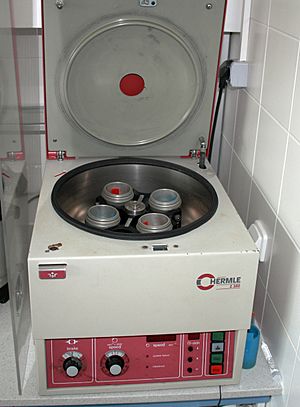Centrifugation facts for kids
Centrifugation is a cool way to separate things using a special kind of force called centrifugal force. Imagine spinning something really fast; the centrifugal force pushes things away from the center. In a centrifuge machine, this force helps separate tiny particles from a liquid mixture. It works because heavier or denser particles get pushed to the bottom of a test tube, forming a solid clump called a pellet or precipitate. The lighter liquid that stays on top is called the supernatant.
This method is super useful because it makes things separate much faster than if you just waited for gravity to do the job. Think of it like a super-speedy way to sort out mixtures!
Contents
How Centrifugation Works
When you spin a mixture in a centrifuge, the particles inside experience a strong outward push. This push is much stronger than regular gravity. Because of this strong force, particles separate based on their:
- Size: Bigger particles usually settle faster.
- Shape: The shape of a particle can affect how easily it moves through the liquid.
- Density: Denser (heavier) particles move to the outside (bottom of the tube), while less dense (lighter) particles stay closer to the center (top of the tube).
The faster the centrifuge spins, the stronger this separating force becomes, and the quicker the particles separate.
Measuring Centrifuge Speed
The speed of a centrifuge is usually measured in two ways:
- RPM (Revolutions Per Minute): This tells you how many times the spinning part (called the rotor) goes around in one minute.
- G-force (or g): This is a more accurate way to measure the separating power. It tells you how many times stronger the centrifugal force is compared to Earth's gravity. For example, 1000 g means the force is 1000 times stronger than gravity!
The g value depends on both the RPM and the size of the rotor. A bigger rotor spinning at the same RPM will create a stronger g force.
Where is Centrifugation Used?
Centrifugation is a very important process used in many different areas, from science labs to big factories.
In Science and Medicine
- Biology and Chemistry Labs: Scientists use centrifuges all the time to separate parts of cells, blood, or other biological samples. For example, they can separate red blood cells from plasma, or isolate tiny parts of cells like DNA or proteins.
- Analyzing Molecules: It helps scientists study the properties of very large molecules, like how they move in liquids.
In Industry
- Food Industry: Centrifuges are used to separate cream from milk, clarify juices, or remove impurities from oils.
- Water Treatment: They help remove solid waste from dirty water, making it cleaner.
- Chemical Production: In factories, special centrifuges can continuously separate solids from liquids in large amounts.
- Uranium Enrichment: This is a very specific and important use. Centrifuges are used to separate different types of uranium atoms (Uranium-238 and Uranium-235) to make fuel for nuclear power plants. This process relies on the tiny weight difference between these atoms.
Centrifugation is a simple but powerful technique that helps us understand and process many different materials in our world.
See also
 In Spanish: Centrifugación para niños
In Spanish: Centrifugación para niños
- Laboratory centrifuge
- Centrifugal force
- Density
- Precipitation (chemistry)


